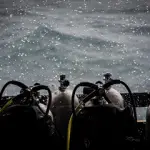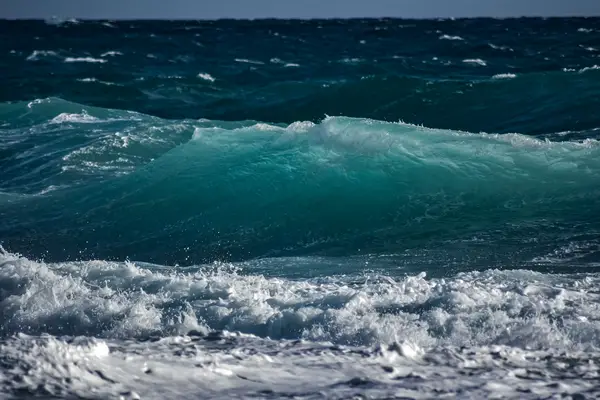
Tips for scuba diving on wind and sea conditions
Too much wind in the wrong direction can ruin any plans for diving, unless you have a plan B and a big enough boat to get to a more sheltered dive spot.
So how much wind is too much for diving? Force 4 to 5 with wind speeds of between 13 to 24 mph (20 to 38 km/h) can be too much wind for diving, as this can produce wave heights of up to 3 metres (10 foot). When you bear in mind that many diving operations will cancel dives with wave heights of 5 foot and over. So 10 foot waves are high!
The best way to do more diving is to book yourself on a scuba diving liveaboard. You can check the latest and best deals on liveaboards using the following window:
Having said that, there’s a lot more to this than just how much wind is too much for diving. So let’s take a look at this in more detail. But as always with the idea to keep things safe when you’re diving.
Towards the end of the article I explain how to check dive conditions. But first let’s consider what is considered strong wind in km/h or mph for diving.
How much wind is too much for diving and what is considered strong wind km/h, mph or knots
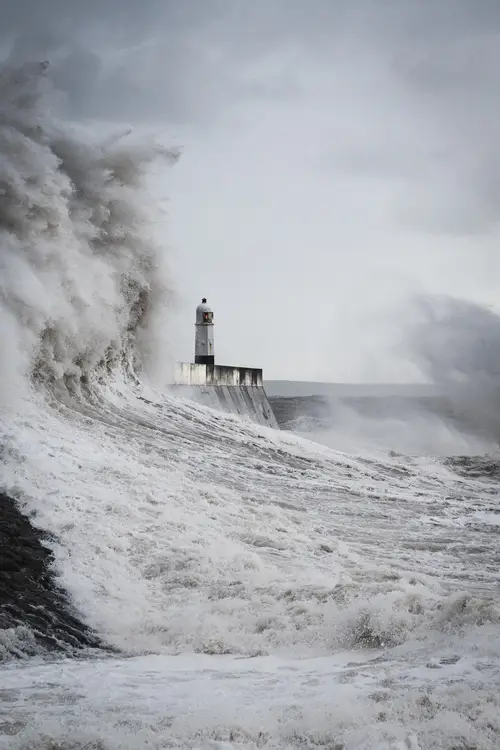
For divers it’s not the wind that’s the problem as such, it’s the sea conditions that arise out of the strength of the wind that causes the problem.
To understand why the question about how much wind is too much for diving is so important, it’s just as important to understand how much wind affects sea state. Then as a result how diving is affected by the state of the sea. This is best explained by way of a table.
Scuba Diving Conditions Wind Speed Vs Wave Height
| Beaufort Number Scale | Wind Speed | Wave Height | Diving Conditions |
|---|---|---|---|
| Up to Force 3 | 1-12mph 2-19km/h 1-10knots | 0-4feet 0-1.2metres | Good for most small to large boats. OK for all diver certifications + experience. (For novices or beginners: In 4-foot wave height find a sheltered dive site. Warn those who suffer from seasickness) |
| Force 4 | 13-18mph 20-28km/h 11-16knots | 3.5-6feet 1-2metres | Not safe to dive if wave height > 5ft: (Find a dive site with less wave height, But only if safe to pilot boat to dive site. If your boat is large enough to cope with sea conditions, warn those who suffer from seasickness Not safe for beginner divers.) |
| Force 5 | 19-24mph 29-38km/h 17-21knots | 6-10feet 2-3metres | Not safe for diving from dive boat. Dive only if safe to pilot boat to sheltered dive site. Conditions will be uncomfortable in small dive boat. Warn those who suffer from seasickness Definitely not safe for beginner divers. |
| Force 6 and above | 25-73mph 39-118km/h 22-64knots | 9-46feet 3-14metres | Extremely dangerous diving conditions. Dive only if safe to pilot boat to sheltered dive site. Conditions will be uncomfortable in small dive boat. Warn those who suffer from seasickness. Note: The higher the Force > 6 the more dangerous. If it looks dangerous, then it probably is! |
The above information relating to the Beaufort Scale, wind speeds and wave height has been taken from Wikipedia: Beaufort Scale.
Video of getting on to a boat on pitching boat
It’s worth watching the video below. Especially if you’ve not dived from a hard boat before. The sea state isn’t too bad and I’d say the wave height is between 2-3 feet. So you’ll see how long it took this diver to climb aboard using an open rung ladder.
Imagine if you would, wave heights of 5-6 foot and then trying to do the same boat boarding and exiting the water. The video has been set to start just as the diver is nearing the surface.
What considerations do you have to take into account with wind, sea state and scuba diving?
There are a number of considerations you need to thinking about when scuba diving in windy conditions. These include the following:
Factors to consider with wind and sea state with scuba diving:
- Getting to and from the dive site.
- Type and size of of boat.
- Getting into and out of the water.
- Diver experience.
- Depth of water.
- Underwater visibility.
- Fetch, wind direction. and wind over tide.
- Alternative dive locations.
- How susceptible you are to sea sickness.
- Safety on the boat.
- Losing divers with high waves.
- Shore diving.
Let’s take a look at each of these in more detail.

1. Too much wind can inhibit getting to and from the dive site
It’s all very well that the dive site is sheltered from strong winds, but if you can’t get to the dive site, this is a problem. But also after a dive you need to be able to get back to port.
Safe diving is all about planning the dive and diving the plan. As I’ve also been involved in planning the dive boat trip for dives, as well as the dives themselves, I know how important it is to also plan the boat ride to and from the dive site.
I’m also a keen sailor, so I know from experience how important it is to plan ahead for weather and wind conditions. Especially when you have a wife who gets seasick!
Which means if you are in charge of planning the trip to the dive site, you must also check the weather forecasts to make sure your return journey will be equally as easy. Or certainly not dangerous.
I remember diving in the Mediterranean once and we were on quite a large hard boat. We were about 35 minutes into the trip and the skipper aborted the trip and returned to port. He did this because the winds and seas were already picking up. He wanted to make sure everyone returned safety. Plus it was unlikely the divers would get in and out of the water safely. See point 3 below.
2. How much wind is too much for diving will be affected by the type and size of of boat you have
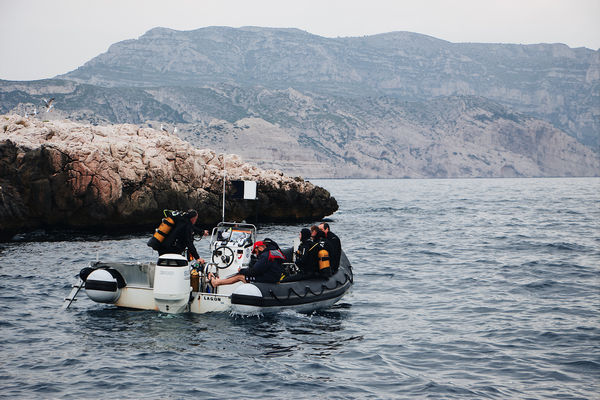
If strong winds have whipped the sea up into a choppy state, the smaller the boat the worse the boat ride will be. But also, the smaller the boat, as the sea state worsens, the more dangerous it becomes to be out on the water.
If you’re out in rough seas, this is when things get broken on a boat. This can include the engine. You don’t want to be out at sea in a boat without an engine!
How much wind is too much for diving is affected by wave period or frequency
The other factor to affect the ride comfort and safety is wave frequency. The closer the wave frequency, the worse the ride. Your boat can take quite a bashing in close wave frequencies. Which means you and your on-board divers will too!
The distance of the swell and the correlation between wave height and wave period or frequency makes a big difference to boat ride and the safety of getting in and out of the water. The closer together these two are, the steeper the face of the wave will be.
For example 8 foot (2.4 metre) swells with a 20 second interval are nothing but a ground swell and would be easily diveable. But a 4 foot (1.22 metre) wave height with a short 4 second interval would eat you alive. Not only would your boat be smashed about, but getting divers out of the water would be near impossible.
Having said that, RIBs are great for cutting through choppy waters. But even with a RIB the worse the sea state, the longer the boat needs to be for you to be safe and comfortable. If the RIB is longer it won’t dive down into the troughs as much as a shorter RIB will.
Often on the larger hard boats and liveaboards the divers will transfer to a smaller boat to take you to the dive site. On many of the liveaboards you’ll transfer onto a Zodiac inflatable dive boat.
If you’ve not experienced diving from a liveaboard yet, you might want to take a read of this article about what to expect on your first liveaboard. This includes a section on how to choose your first liveaboard.
3. How much wind is too much for diving is decided by how difficult the resulting sea state affects getting in and exiting the water

As explained above, in general the stronger the winds, the higher the waves will be. This becomes a problem because the higher the waves, the more the boat will pitch. Rough seas on their own aren’t generally a problem for putting divers in the water. But picking them up afterwards is another matter!
So it’s not necessarily getting divers into the water where wave height is a factor and whether a dive trip goes ahead. Getting into the water is quite straight forward, subject to kitting up safety (see point 10 below). But where the problem lies is exiting the water after the dive.
Having said that, I don’t underestimate your entry into the water from a dive boat. You need to be more aware and careful when entering the water when the dive boat is pitching more than normal.
For entry into the water from a hard boat, most divers use the giant stride. For this it’s important you do a proper stride away from the boat so your scuba tank doesn’t hit the boat.
You might like to take a quick read of this article about the 5 different entry techniques. I not only explain five different ways to enter the water, but I also give some extra tips for each entry type, including the giant stride.
Using a ladder in windy and rough sea conditions
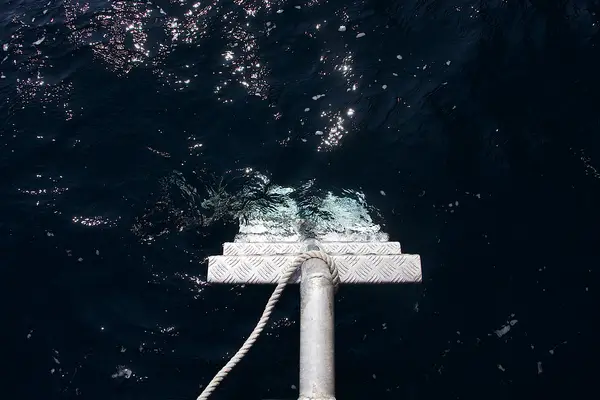
If you’re diving from a hard boat, you’ll mostly get out of the water using a ladder. In choppy seas this ladder will be rising up and down in the water. In windier conditions and heavier seas, you’ll even find the ladder comes right out of the water and becomes airborne!
Timing is the key to this. Arguably it’s best to grab the ladder as it’s stabbing into the water on the downswing. But be careful not to get yourself underneath the ladder, especially if the bottom of the ladder leaves the water. Otherwise you could find the ladder hitting your skull!
What is the best way to get back on a dive boat is an electric lift. These are great and much safer, but not many dive boats have them.
4. How much wind is too much for inexperienced scuba divers?
How much wind is too much for inexperienced beginner scuba divers is different than it is for those with experience. For example, you may not want to take complete novices on a hard boat for the first time when the seas are more than 2-3 feet (0.6-0.9 metres) high.
Jumping into the water shouldn’t be a problem for novices with waves at 4 feet. The dive itself should go smoothly too. But it’s at the end of the dive when you have to get these beginner divers back on to the boat when the fun may start. I say fun, but I don’t mean it in the sense it will be any fun for the novices themselves or for the instructor or more experience dive buddy.
The last thing you want is for their first experience of diving from a hard boat to be faced with a ladder violently lifting up and down out of the water. Their first time of using a ladder should be in calmer seas first.
The more time beginners have in the water, the more they will learn and the more skills for diving in differing conditions they’ll gain.
But as a guide, in South Florida, some dive boats cancel dive trips in 4-5 foot (1.22-1.5 metres) swells, but all of them cancel at more than 6 foot (1.83 metres) swells.
5. How much wind is too much for diving is affect by the depth of the dive
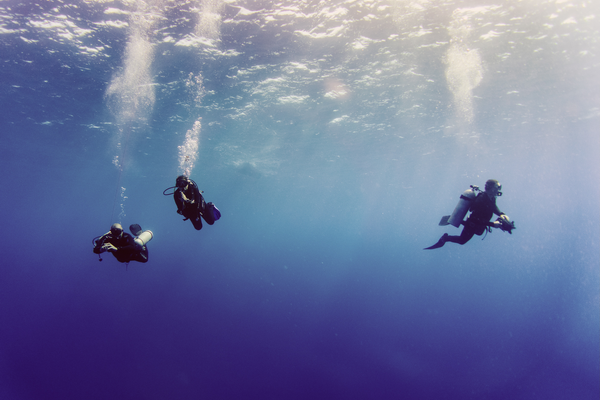
The depth of the water and the depth of the dive needs to be a consideration too. Even though at the surface the waves might be 5-6 feet (1.5-1.83 metres ) high, below around 10-15 metres (32-50 metres) down you won’t necessarily notice the wave action. But of course, whilst it might be okay to enter the water from a dive boat with 5-6 feet waves, exiting is another matter.
But deeper swells will affect you though. However, this isn’t a problem, so long as the swell of the water doesn’t stir up the silt on the bottom and affect visibility.
6. Too much wind will affect water visibility depending on the sea bed
It’s usual for the water to get stirred up when you have strong winds and turbulent seas. Also, with stronger winds you get a bigger swell too. The stronger the winds, the more the seas get stirred up. With turbulent seas and swell the seabed gets stirred up and reduces the visibility underwater.
This isn’t always the case, as it depends whether there’s sand on the seabed. It is the sand particles that get mixed in with the water that cuts down on visibility.
It maybe that the winds have calmed down, but due to the fact the sea have been rough for a few days cause by the strong winds, the visibility will remain poor for a while. Murky diving with poor visibility is no fun.
This is all about knowing the dive sites and which ones will be affected by swell and rough seas.
7. How much wind is too much for diving will be affected by fetch, wind direction and wind over tide

Wind in itself or how strong it is isn’t necessarily the issue. But it is the strength of the wind plus wind fetch, as it’s the fetch of the wind that causes the sea to be rough. Plus if the wind direction is in an opposite direction to the underlying sea current, this is when the waves will be bigger. It’s the opposing effects of wind over tide that can create sea states that are simply not safe to dive.
Wind fetch is the amount of open ocean in the direction the wind is coming from. Which means that if you only have a few miles of open ocean from the direction of the wind, the waves won’t be too high. But if you have hundreds of miles of open ocean, the wave height will be much higher with the same strength of wind.
This is one of the reasons why the waves are so large in Hawaii. Great for surfers, but not so good for scuba divers. The wind carries waves across a wide expanse of the Pacific Ocean. It’s when the seabed rises up towards the Hawaiian islands that the massive waves are formed. The same is true off the coast of Portugal in the Atlantic Ocean, where some of the largest waves in the world are surfed.
Wind direction needs to be factored in when considering your dive
The direction of the wind is an important factor too when working out if there’s too much wind for diving. For example, if the wind is coming from the shore (i.e. it’s an off-shore wind) the sea close into shore will be flat calm. But if you have an on-shore wind that’s coming onto the shore, this is when the waves will be higher.
For shore diving it’s not necessarily about too much wind for diving, it’s a matter of finding a beach in the lee of the wind, or where there’s an off-shore breeze.
8. If there’s too much wind for diving in one spot, it’s good to have an alternative dive location
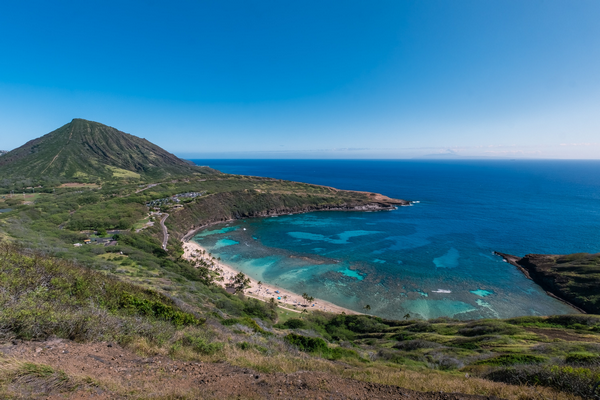
Too much wind may not affect your diving. This is so long as you can get to a protected dive site. For example, if you’re diving on a dive boat from an island you can travel to the leeward side of the island (i.e. the protected side).

The side of the island that’s in the lee of the wind, which is downwind from where the wind is coming and is behind the island. See the above image. For example it would be fine to dive close to shore in a Force 6 North Westerly wind on the South East side of the island (which is the red area in the above image). Versus you probably won’t be able to dive in a Force 6 South Easterly wind on the same side of the island.
Assuming sea state isn’t such that you can’t get from the windward side of the islands to the leeward side of the island, you’ll find the dive sites there will be just fine.
How much was too much wind for diving in Barbados?
There’s a dive site in Barbados that I’ve yet to do and this has always alluded me because of too much wind for diving. Which creates rough seas unsafe for diving. On my last trip to Barbados in 2019 the trip was planned, as Phil from Reef and Wreckers Divers knows how much I want to do this dive. It was an early start at 7am and Phil was going to collect me early from my hotel.
But on the morning plans had to change. It was way too windy and too dangerous to dive. Not the dive itself, but getting back onto the boat. So it was to dive plan B on the leeward side (i.e. West of the Island) of Barbados instead.
If you’ve ever wondered what the diving is like in Barbados, you might like to take a quick read of this article is Barbados good for scuba diving. It’s dive number one on the list of seven that I’ve yet to do. But if you like seahorses, you should take a look at dive number two, where on one occasion I counted over 30 seahorses on one dive!
9. How much wind is too much for diving is affect by how susceptible you are to sea sickness
In general with high winds comes rough seas. Rough seas normally spell disaster for any diver who doesn’t have very good sea legs. Or in order words for the divers who are susceptible to sea sickness, rough seas are a nightmare.
In rough seas you may find that even the best form of seasickness medication does work. The other factor to consider is the length of time waiting in the water. It’s no fun bobbing around in rough seas for any length of time. Especially if you have a propensity to get seasick.
So you may find the Force 4 or Force 5 noted above, might drop down to a Force 3 instead for how much wind is too much for diving. Even in a Force 3 you can experience wind speeds of up to 12mph (19kmp), which can produce wave heights of up to 4 feet (1.22 metres).
In a small boat, and especially with a narrow wave frequency, if you are susceptible to seasickness, you may find this too much.
But also with sea sickness tablets these can make you drowsy and tired.
10. How much wind is too much for diving must take account of safety on the boat
When you have too much wind, which results in bigger waves and boat movement, this will make it more dangerous on the dive boat. Dive kit is heavy. Fully kitted up divers are unstable when they’re on their feet.
The dangers are more pronounced when divers are trying to enter the water fully kitted up. Or after they’ve exited the water still kitted up.
It’s not always easy to get from where you kitted up to the back of the boat when the boat is rolling around. Unless you can do a backwards roll off the side of the boat. This is easy on a RIB, but not always achievable on a hard boat.
The danger comes when divers are trying to balance. It’s when they fall over that they either hurt themselves and/or hurt someone else at the same time. Plus dive kit can and does get broken when someone falls on it.
11. When you calculate how much wind is too much for diving, spotting surfaced divers must be considered
One of the safety aspects to diving is being able to recover divers at the end of a dive. The higher the swell and wave height, the more difficult it is to see surfacing divers. Of course you must use whatever safety precautions you can, like using surface market buoys or delayed surface marker buoys.
If you’re not familiar with a delayed surface marker buoy (DSMB), take a quick read of this article what is a delayed surface marker buoy. The article gives some useful tips for using a DSMB.
But in really rough seas, where there’s a high swell and possibly poor visibility due to spray from the strong winds, you may struggle to spot surfaced divers. Even when they have DSMB’s. I recommend you read the above article on DSMBs, as this gives some good safety tips for this aspect of diving safely.
Spotting divers on the surface is made even harder if you’re on a boat like a RIB. This is because you are lower to the water, which can make it much more difficult to spot divers behind larger waves and further away.
Add an underwater current into the mix and you may have a recipe for disaster. You’ll have divers being pushed off quite some distance, which will make it far more difficult to spot them on the surface.
12. How much is too much wind for shore diving?
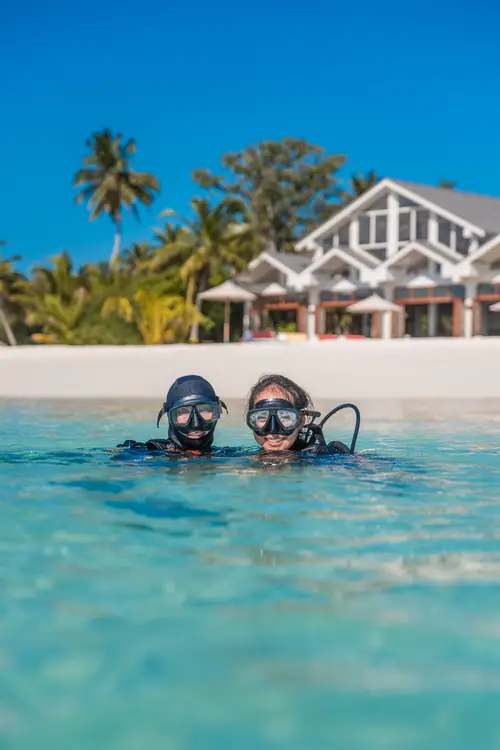
Whether the wind is in an on-shore or an off-shore direction (As explained above), this may affect whether or not you can shore dive. If the waves are too large (2-3 foot and above), this will make it more challenging (and possibly dangerous) to get in and out of the water with dive kit on.
As noted above in the wind/sea state table, if it looks too dangerous, then it probably is!
Find a sheltered bay, preferably with an off-shore breeze, as this will be safer to shore dive. Or dive when the onshore wind isn’t too strong it generates large waves.
But with beach entry and shore dives look out to see, as the wind
speed and seas further out might be different to what they are close in. Consider how far out you will dive. Know the currents and state of the tide (see link to story below in DT Mag). For your safety, think about if you have to surface out to sea.
What are the dangers caused by wave height as a result of too much wind for diving from a boat
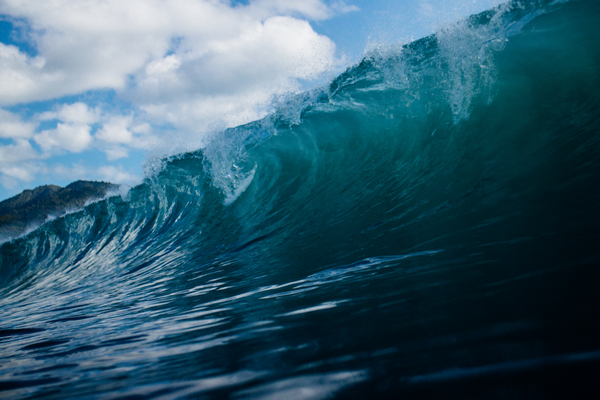
1. Avoiding your head being bashed by the boat
You have to be aware of the boats movement and keep your head away from the hull. You don’t want your head to be hit. If it is, this can be extremely dangerous and it could kill you!
2. Getting your fingers crushed between the ladder and the boat’s hull
When you grab the ladder be careful where you put your hands and fingers, as many ladders swing with the water movement.
Your fingers can get trapped between the ladder and the boat’s hull. Not nice and quite painful!! Try climbing a ladder with broken fingers.
3. Other divers around the ladder
You should always give space around a ladder when a colleague or dive buddy is climbing the ladder. Never be directly behind the ladder, especially in choppy seas. If the diver on the ladder falls back, they will land on top of you if you’re behind them.
If this happens you’ll get a face of scuba tank, which will hurt. It may even knock you out and you could drown! Sorry to be so dramatic, but I’ve seen divers fall off ladders before.
4. Removing diving kit before getting on the ladder
Depending on the ladder, will depend on what kit you remove. Some ladders allow you to keep your fins on as the rungs are open. Whereas others are closed rungs and requires you to remove your fins before you get on the boat.
Be ware of the boat and its movement as you remove your fins or any other kit. But also, only do this when you’re close to or holding onto the line. Once you’ve removed your fins, it’s extremely difficult to swim in full dive kit.
5. Keeping your regulator in your mouth
This is in case you fall back into the water. But also, in choppier waters with waves of 4-5 feet (1.22-1.5 metres) you could be plunged underwater when you’re on the ladder.
6. Falling off the ladder
As already mentioned, it’s possible you could fall off the ladder. To avoid this happening your hand grip is most important. Plus always have at least three points of contact at all times. Either two feet and one hand, or two hands and one foot.
7. Falling on-board the dive boat
Kitting up on a dive boat in heavier seas is more tricky. Sitting down for most of this is best. But if you use a weight belt, you’ll need to stand up to put this on. It’s best to lean forward with your feet at least shoulder width apart.
Getting up the ladder in choppy seas is the first step. But when you’re on-board you need to contend with the roll of the boat, and the other divers. Falling over with a heavy dive tank and kit is not a pretty sight.
8. Approaching surface divers in choppy seas
You always have to be careful when you approach divers on the surface. But this becomes more apparent in choppier seas and windier conditions.
As you near divers you need to put the dive boat in neutral, but in stonger winds, this will blow the boat either towards or away from the divers in the water. You need to take wind speed and direction into account when approaching the divers for pickup.
Plus the choppy seas means you have to be careful with the bow of the boat. You don’t want to put a pitching boat bow above a diver, as you could hit them and knock them out!
9. Consider changing sea-state during the dive
How much wind is too much for diving is not necessarily just at the beginning of the dive. You also need think about the potential for the sea state to worsen during the course of the dive. Bearing in mind what I’ve explained above about exiting from the water onto a dive boat after the dive being the more difficult part.
It could be that entering the water is easy. But over the course of the dive the wind picks up, as does the sea state. You don’t want to find you can’t get your divers back on board after the dive. With this scenario, you need to consider the experience of the divers you have on the boat.
How to check dive conditions
Where ever you are in the world, and before you plan to dive, check the weather, the tides and sea state.
Weather is the most important consideration in evaluating diving conditions because it impacts conditions both above and below the water. In fact, few other leisure activities are as much at the mercy of the weather as diving.
Alex Brylske – DT Mag – Assessing Conditions – I recommend you read this whole article and beginning story.
You can get whether checks from the TV or from the radio. But if you missed this, you can check this online. But a very useful site to check is The National Data Buoy Centre.
To use this page, zoom in on the area you intend to dive. Click on one of the ‘yellow’ diamonds and this will give you information on wind and wave heights. When the diamonds are red this indicates there are no recent (i.e. < 8 hours) meteorological data for this station.
Before you dive, get the most recent information from the buoy closest to your dive site. Use this information to make the best decision possible by factoring in wind strength, wave height and period and diver experience.
You can also use an app on your phone. The one I often use is Predict Wind. This is more of a sailing app, but works just fine for checking the wind for diving conditions too.
To conclude on how much wind is too much for diving
You should never under estimate the power of moving water. This is the same whether it’s entering the water for a shore dive, or diving on a drift dive in a current.
Often times the best decision to be made is to simply dive another day. Always safety first. and bear in mind that whether it’s shore or boat diving, waves are not for the faint hearted.
And just to be safe…if it looks too dangerous, then it probably is!
I hope you enjoyed this article about how much wind is too much for diving
If this article hasn’t answered all of your questions. If you have more questions either about snorkelling or scuba diving (or specifically about how much wind is too much for diving), please comment below with your questions.
There will also be many more articles about scuba and scuba diving safety tips (and on snorkelling too) for you to read and learn about this fabulous sport.
Have fun and be safe!


